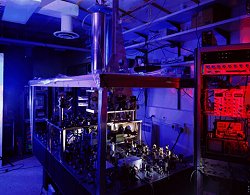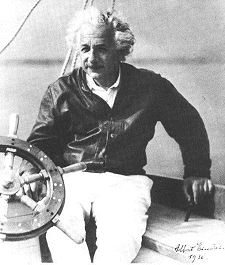|
Scientists are building atomic clocks that
keep time with mind-boggling precision. Such devices will help farmers,
physicists, and interstellar travellers alike.
by Linda Voss and Dr Tony Phillips
"I must go down to the
seas again, to the lonely sea and the sky
And all I ask is a tall ship and a star to steer her by;" from Sea
Fever by John Masefield, 1900.
In John Masefield's poem, "Sea Fever,"
all he needs to roam the seas is "a tall ship and a star to steer
her by." In fact, a good clock was just as important. Mariners who
navigated by the stars needed to know when they were looking
at the sky. Otherwise their charts and tables would be useless.
At the time Masefield wrote his poem,
at the beginning of the 20th century, navigating by the stars had
been made much more accurate by the invention of maritime chronometres.
They were spring-driven clocks that, once set, kept the time within
a fraction of a second each day.
In the 21st century, our ships travel
much greater distances - not only from London to New York, but from
Earth to Mars and beyond. As a result, the accuracy of our time
pieces must be greater as well.
Modern navigators rely on atomic clocks.
Instead of old-style springs or pendulums, the natural resonances
of atoms - usually cesium or rubidium - provide the steady "tick"
of an atomic clock. The best ones on Earth lose no more than one second
in millions of years.
That's impressive, but scientists working
in NASA's Fundamental Physics Program would like to do better. For
those of us who mutter "just a minute" when we mean "half-an-hour,"
improved precision might seem overboard. Yet there are many uses
for it: to test theories of gravity, for example, to guide spaceships,
and to solve a surprising variety of down-to-earth problems.
Sailers, truck drivers, soldiers, hikers,
and pilots ... they all rely on atomic clocks, even if they don't
know it. Anyone who uses the Global Positioning System (GPS) benefits
from atomic time. Each of the 24 GPS satellites carries 4 atomic
clocks on board. By triangulating time signals broadcast from orbit,
GPS receivers on the ground can pinpoint their own location.
Tiny instabilities in those orbiting
clocks contribute at least a few metres of error to single-receiver
GPS measurements. Making the clocks smaller (so that more of them
can fit on each satellite) and increasing their stability could
reduce such errors to fractions of a metre.

A new generation
of growers called "precision farmers" rely on GPS and atomic
clocks.
|
Pilots landing on narrow airstrips at
night would appreciate the improvement. So would surveyors, prospectors,
search and rescue teams, and farmers. "Precision farmers" already
use GPS-guided tractors to dispense custom-doses of water, fertiliser
and pesticides over garden-sized plots. Better GPS data could guide
those tractors to individual rows or perhaps even to individual plants
for special care.
"One day, we'll want to have GPS satellites
around other planets, too," notes Don Strayer of NASA's Fundamental
Physics Program at JPL. For example, a Martian Global Positioning
System could guide explorers - both robot and human - across the
Red Planet. Less likely but possible: Future farmers on Mars might
want GPS to help them tend crops as their cousins on Earth do. Martian
fields will definitely need special care.
Atomic clocks on board GPS satellites
are stable "within 1 part in 1012," says Lute Maleki
who supervises JPL's Quantum Sciences and Technology Group. That
means an observer would have to watch a GPS clock for 1012
seconds (32,000 years) to see it gain or lose a single second. "To
guide spacecraft from planet to planet we use clocks that are even
better - good to 1 part in 1014," he added.
Recently scientists have built atomic
clocks that are better still - "stable to about one part in 1015,"
notes Maleki. They did it using a new technique called "laser cooling."
In the 1990's several groups of researchers made a counter-intuitive
discovery: Shining lasers on atoms can cool them to temperatures
only a millionth of a degree above absolute zero. Such cold atoms
make excellent "pendulums" for atomic clocks, explains Strayer,
"because lower temperatures allow the natural frequency of the atom
to be measured more accurately."

more
NIST-F1, a
laser-cooled atomic clock in Boulder Colorado, is the primary
time and frequency standard for the United States.
|
If cold atoms are good, then floating
cold atoms are even better.
"The International Space Station is
a great place for atomic clocks because the station is freely falling
around the Earth," Strayer continued. Slow-moving atoms in a cooled
weightless clock can be observed for a longer time, and they're
less likely to hit the walls of their container in mid-oscillation.
If all goes as planned, a laser-cooled
clock named PARCS will be installed on the ISS in late 2004 or 2005.
Experts expect it to be the most stable clock ever, keeping time
within 1 second every 300 million years (1 part in 1016).
According to Einstein's theory of gravity
and space-time - called "general relativity" - clocks in strong
gravity tick slower than clocks in weak gravity. Because gravity
is weaker on the ISS than at Earth's surface, PARCS should accumulate
an extra second every 10,000 years compared to clocks ticking on
the planet below. PARCS won't be there that long, but the clock
is so stable that it will reveal this effect in less than one year.
(Strayer notes that clocks on GPS satellites experience this relativistic
phenomenon, too, and that onboard systems must correct for it.)
"Putting atomic clocks in orbit is
a good way to test general relativity," says Maleki. "General relativity
has passed every test so far, but no theory is perfect - not even
Einstein's. Eventually, as we extend the precision of our experiments,
we expect to find flaws in it, and that will dramatically change
what we know about the nature of the Universe."

More
Albert Einstein
at the helm of a
sailboat in 1932
|
The stretching of time by relativity has
been felt and measured by other orbiting clocks - GPS, for example
- but PARCS will measure the effect with errors one hundred times
smaller than its predecessors did. Furthermore, PARCS will test technologies
to be used in a next-generation clock named RACE slated for installation
on the ISS in 2006. Stable within 1 part in 1017, RACE
will keep time so well that if it ran for three billion years it would
lose less than 1 second.
Clocks like RACE will test physics
like never before. They will improve telecommunications on Earth
- "in ways we can't imagine yet" says Maleki - and do wondrous things
for navigation. Indeed, with RACE on board, a mariner could navigate
not only by the stars, but between them as well.
Perhaps if Masefield were alive today,
he would craft his poem differently: "I must RACE down to the launch
pad, to my craft so sleek and true; All I need is a stable clock
and a star to steer her to...."
|
